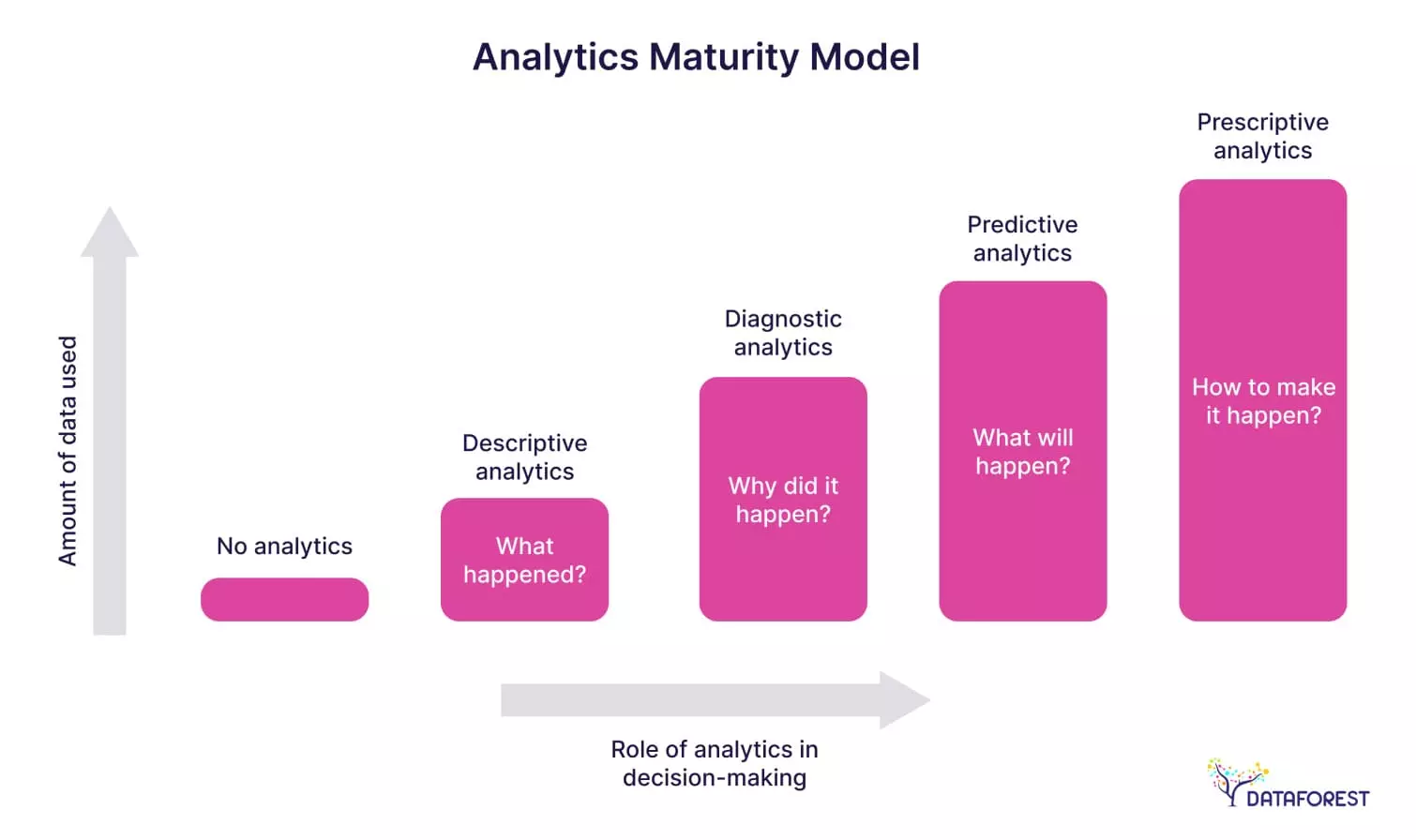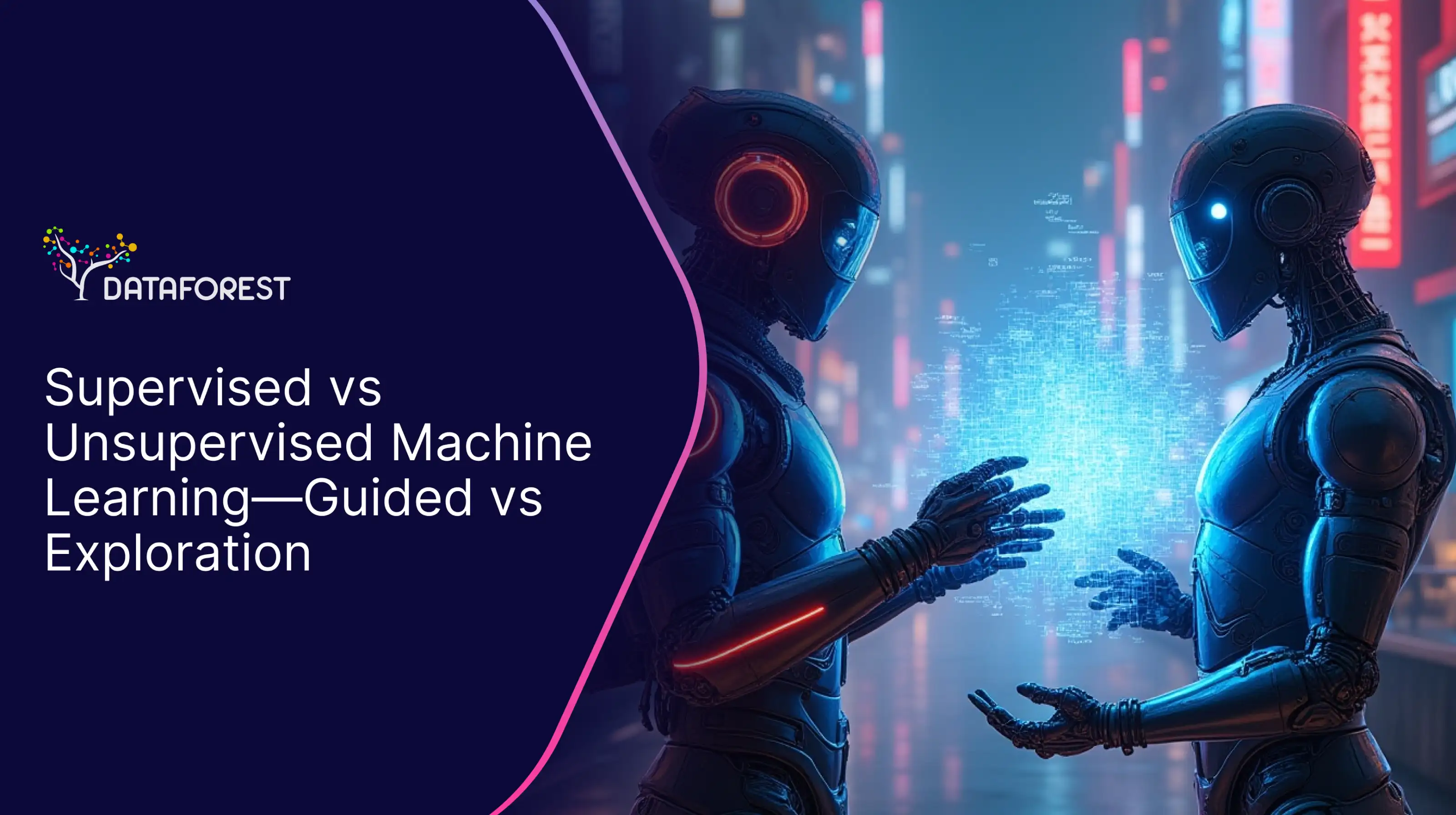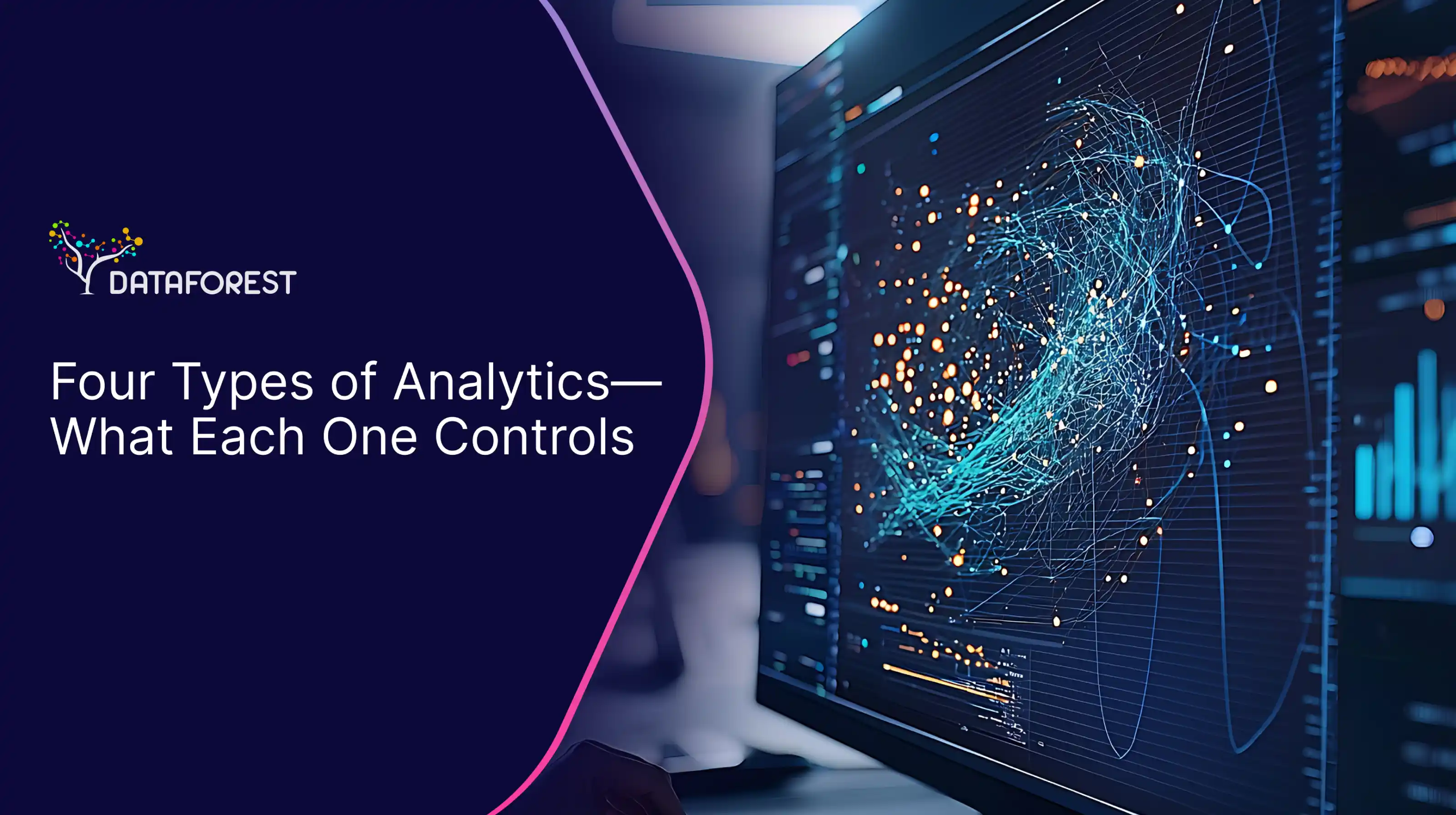The concept of “predictive analytics” emerged naturally from the increasing availability of digital data and the desire to use it to anticipate future events and trends. Why is predictive analytics important? It uses data and fancy math to make educated guesses about what might happen in the future. Let us introduce the version of the Predictive Analytics overview. If you are interested in this topic, please arrange a call—we will explain everything in detail.
What is the Definition of Predictive Analytics
Predictive analytics uses data and fancy math to make educated guesses about what might happen in the future. Imagine you're planning a party and want to predict how many guests will appear. Instead of just guessing, predictive analytics looks at past-party data to make a more accurate guess about this time. Due to the introduction of predictive analytics, companies collect a bunch of info about customers, sales, and other stuff in business. Using predictive analytics introduction, they analyze it to make predictions about things like future sales, customer behavior, or trends. What is predictive data analytics? — book a call for an answer.

Building Tomorrow's Insights with Predictive Analytics
Picture how many ice creams people buy and the temperature outside. Data engineers gather and organize this data. Predictive analytics takes it and uses math tricks to find hidden patterns. It could be things like "People buy more ice cream when it's hot." Data engineers set up the tools and systems that let these math tricks happen smoothly. Using patterns, the machine predicts stuff: if the temperature is scorching tomorrow, a lot of ice cream will be sold. And voila: businesses make plans ahead of time. That’s why predictive analytics matter.
Your Crystal Ball for Smarter Decisions
If you're a store owner, you want to know what stuff your customers might buy in the coming months. Predictive analytics uses past data to make predictions: "It looks like people might buy more umbrellas if it's going to rain a lot next week." It helps businesses to stock up on umbrellas before the rain starts so they're ready when customers need them. It's not magic, but pretty intelligent math allows companies to make better decisions. In a world where things change fast, having a good guess about what's coming makes a difference.
The Fusion Behind Key Components of Predictive Analytics
Key components of data predictive analytics are formed through a blend of data analysis, mathematical modeling, and pattern recognition to foresee future outcomes from historical information. Book a call, get advice from DATAFOREST, and move in the right direction.
The Blueprint of Predictive Analytics
Let's break down what predictive analytics is based on:
- Data Collection. Data collected from various sources could be sales numbers, customer info, weather data, or anything relevant to your prediction.
- Preprocessing and cleaning up the data. You remove any errors, duplicates, or irrelevant bits. It's like tidying up your room before inviting guests over.
- Modeling. You use different mathematical models to find patterns in the cleaned-up data. These models are like the tools that help you understand how things work.
- Validation. You need to test how accurate your predictions are. You use a different data set your models have not seen before to see if they can predict well.
These four parts are predictive analytics basics: you gather ingredients, clean them, mix them, and then make sure the cake tastes as good as you hope.
The Evolution of Predictive Analytics Architecture
Predictive analytics architecture evolved through a combination of data-driven insights, technological advancements, iterative experimentation, and real-world applications, culminating in a structured framework for making accurate predictions from complex datasets.
Architecting Tomorrow: The Framework for Effective Predictive Analytics Implementation
- Gather data-based info from various sources, such as sensors, or websites, and store it in a centralized repository that is easily accessible for analysis.
- Clean the data by removing errors, handling missing values, and transforming it into a consistent format. This step ensures your analysis isn't skewed by messy data.
- Select and create meaningful features from your data to help your models make accurate predictions: mathematical transformations or combining different data points.
- Choose the suitable predictive model for your data and prediction task. It could be linear regression, decision trees, neural networks, or more advanced algorithms.
- Feed historical data into your chosen model to let it learn and find patterns. The model adjusts its parameters to make better predictions over time.
- Test your trained model with new, unseen data to see how well it predicts. You ensure it's accurate and not just memorizing the past data.
- Integrate your trained model into your business operations. It could be used for real-time predictive analytics or support decision-making.
- Continuously monitor the model's performance. If its predictions start to dip in accuracy, it might need a tune-up with new data or parameter adjustments.
- Use the outcomes of your predictions to refine your models further. It creates a continuous improvement loop as your models improve at foreseeing future events.
- Ensure your architecture can handle larger datasets and increased computational demands as your business grows.
How Characteristic Features of Predictive Analytics Take Shape
The predictive analytics features are determined by analyzing historical data, identifying relevant variables (factors that influence the outcome), and using math models to uncover patterns and relationships within the data. These features help create a predictive model that accurately forecasts future events or results.
Diving Deep into Predictive Analytics Techniques
Each technique has strengths and best use cases. Like tools in a toolbox, you pick the one that fits your job.
Regression Analysis
Linear regression helps us understand how one variable changes as another changes. For example, it can tell you how the price of houses changes with the increase in their size. Polynomial regression is like a fancier puzzle piece that can handle curved relationships. Logistic regression is excellent for predicting probabilities, like whether a customer will buy a product based on age and browsing behavior.
Decision Trees
Imagine playing 20 Questions. Each question narrows down possibilities until you arrive at an answer. Decision trees work similarly, breaking down a complex decision into more straightforward questions. They are based on features from your data, and each branch leads to a prediction. Decision trees are easy to understand, like a game, but they become complex as they learn intricate patterns.
Neural Networks
These are inspired by our brains' interconnected neurons. In a neural network, nodes process and pass data to other nodes. They're stacked in layers, each learning a different abstraction level. Neural networks excel at handling complex data like images, speech, and text. Deep learning, a subset of neural networks, uses many layers to learn intricate patterns.
Random Forest
Picture you're making an important decision, and you ask a group of friends for their advice. Each friend has their own perspective, and you listen to the majority. Random forests are like that group of friends. They're made up of multiple decision trees that make predictions, and the final prediction is based on the consensus. It reduces overfitting and makes your predictions more reliable.
Support Vector Machines (SVM)
Picture a playground where you want to separate two groups of kids playing. You can't put a wall, so you find the best fence that separates the groups. SVMs do something similar with data. They see the best line or curve (hyperplane) separating different data point classes. It's excellent for classification tasks like spam or not-spam emails.
Time Series Analysis
If you're looking at data that changes over time, like sales or stock prices, you're dealing with a time series. Time series analysis looks for patterns in data points that follow a sequence. It predicts future values based on past trends, making business planning and decision-making crucial.
Clustering
Think of a giant jigsaw puzzle with pieces that naturally fit together. Clustering aims to group similar data points together based on their features. It finds segments within your data, like identifying different types of customers or market segments.
Ensemble Methods
Like asking several people for advice when deciding, ensemble methods combine multiple models for a more accurate prediction. They're instrumental when no single model shines on its own. Bagging and boosting are standard ensemble techniques that use different strategies to improve model performance.
Feature Scaling and Selection
When cooking, you don't want one ingredient to overpower the others. Similarly, in predictive analytics, features should be balanced. Scaling adjusts the range of your features so no single part dominates. Feature selection is about picking the most relevant features. You want to use only some things in your kitchen; you choose the key ingredients that create the best result.
Cross-Validation
Imagine you're studying for an important test. You don't want to practice only with questions you've seen before. Cross-validation is like using a mix of old and new questions to test your knowledge. It ensures your model isn't memorizing answers but truly understanding the data.
Weighing Pros and Cons
To identify predictive analytics' advantages and disadvantages, assess its ability to make accurate predictions while considering potential biases and the complexity of data handling.
Exploring the Multi-Faceted Benefits of Predictive Analytics
- Predictive analytics in data analytics benefits may include insights based on data analysis, which can help businesses make informed decisions rather than relying solely on guesswork.
- Businesses that effectively use predictive analytics gain a competitive edge by being proactive rather than reactive.
- Predictive analytics analyzes customer data to understand customer behavior, preferences, and needs. This knowledge enables personalized product recommendations.
- Predictive analytics helps identify potential risks and fraud. Financial institutions use it to detect unusual spending patterns.
- Predictive analytics optimizes resource allocation. Supply chain management predicts demand, preventing overstocking or stockouts and minimizing wastage.
- Predictive analytics refine marketing efforts. They identify the most effective channels, timing, and content, ensuring the efficient use of marketing resources.
- Businesses predict demand for new products and features by analyzing customer feedback and market trends.
- Predictive analytics forecasts which customers are likely to churn (stop using a service or product). This knowledge allows businesses to implement retention.
- In the medical field, predictive analytics aids in early disease detection, personalized treatment plans, and patient outcomes prediction.
- Predictive analytics analyzes historical data and market conditions to determine optimal pricing for products and services. This option is also among predictive analytics' advantages.
The correspondence of the points indicates how reliable is predictive analytics.
Potential Drawbacks of Predictive Analytics
- Predictive analytics relies heavily on data, often personal or sensitive information. Mishandling this data leads to privacy breaches, eroding customer trust.
- While predictive models are powerful, they're not infallible. They're only as good as the data they're trained on, and unexpected factors make predictions inaccurate.
- Biased data leads to personal predictions. If historical data contains biases, predictive models perpetuate those biases, causing unfair outcomes for specific groups.
- Advanced predictive models are highly complex. Explaining why a model made a particular prediction can be challenging, hindering transparency and accountability.
- Developing effective predictive models demands data science, statistics, and domain knowledge expertise. Organizations might need to invest in hiring skilled personnel.
From Data Analysis to Future Predictions
The main predictive analytics concepts require analyzing historical or survey-based data, identifying patterns, building models, and making future predictions based on those patterns.
Exploring Advanced Concepts in Predictive Analytics
These advanced concepts expand the predictive analytics toolkit, allowing businesses to tackle more complex challenges and derive insights from intricate data scenarios.
Ensemble Methods
Think of ensemble methods as forming a dream team of models. They're designed to overcome the limitations of individual models by combining their predictions. Bagging (Bootstrap Aggregating) creates multiple versions of a model by training on different subsets of the data. These models then vote on forecasts. Boosting, on the other hand, focuses on improving the areas where previous models struggled. It's like having teammates with different skills who collectively excel in tackling a challenge.
Time Series Analysis
Time series analysis is the compass in a world where things change over time (think sales data, temperature readings, or stock prices). It digs into the historical data sequence to uncover trends, and seasonal patterns, and even predict future values. For instance, it can help retailers anticipate holiday shopping spikes or manufacturers plan for seasonal production variations. It's like having a crystal ball for understanding data's rhythmic dance through time.
Anomaly Detection
Anomaly detection identifies data points that don't fit the regular patterns. For example, if you're tracking athletes' heart rate during a race, the sensor would raise an alarm if someone's heartbeat suddenly went way off track. In data terms, this could be spotting credit card fraud by identifying unusual spending patterns or finding defective items in a production line by detecting outliers in quality metrics.
You should choose your concept of predictive analytics due to business goals.
Unlocking Future Success: The Value of Predictive Analytics
Predictive analytics allows businesses to anticipate future trends, make informed decisions, and gain a competitive edge by uncovering patterns hidden within historical data. It suits the primary purpose of predictive analytics, which is how can predictive analytics improve performance measurement. By analyzing past data and identifying patterns, businesses can set more accurate performance goals, track progress more effectively, and identify areas for improvement.
Pioneering Business Excellence
Predictive analytics isn't just a tool — it's a strategic asset that drives growth, efficiency, and innovation across the business spectrum.
- The company forecasts customer demand more accurately by analyzing past data and spotting patterns. This means they stock up on popular products and optimize pricing, which is also a benefit of predictive analytics.
- Businesses avoid overstocking or understocking their inventory, thus reducing storage costs and waste.
- Knowing customer behavior and market trends fuels innovation, helping teams develop new products or services that align perfectly with customer desires.
- Businesses face various risks, from economic fluctuations to supply chain disruptions. The data for predictive analytics manages these risks by identifying potential issues early.
- Predictive analytics provides insights for long-term strategic planning by anticipating shifts in customer preferences and market trends.
- Predictive analytics encourages a data-driven mindset across a team. Instead of relying on gut feelings, decisions are backed by data insights.
- Predictive analytics enables targeted and personalized marketing efforts. By understanding predictive analytics and customer preferences, businesses tailor messages and offers.
- Whether predictive analytics adjust inventory levels during a sudden demand surge or change pricing due to market fluctuations, businesses can respond swiftly.
Harmonizing Business Excellence with Predictive Performance Analytics
Predictive analytics isn't confined to one department; it's a versatile tool that empowers multiple business functions to make data-driven decisions, streamline operations, and achieve better outcomes.
- Marketing
- Predictive analytics helps marketers group customers based on behavior, preferences, and demographics in the customer journey concept.
- Predictive analytics tailors marketing messages and offers to individual preferences by analyzing customer data boosting engagement and conversion rates.
- Predictive models identify customers likely to churn, allowing marketers to proactively engage and retain them through tailored incentives or communication.
- Marketers analyze past campaign performance and predict which strategies will yield the best results, optimizing resource allocation.
- Finance
- Predictive analytics evaluates credit risk by analyzing customer data, payment history, and other factors. It assists in making informed lending decisions.
- By identifying unusual patterns in transaction data, predictive analytics helps financial institutions detect fraudulent activities in real-time.
- Predictive models analyze market trends and historical data to guide investment decisions, minimizing risk and maximizing returns.
- Financial teams forecast future revenue based on historical sales data and market trends, aiding budgeting and financial planning.
- Operations
- Predictive analytics forecast demand, helping operations teams adjust inventory levels and streamline supply chains to efficiently meet customer needs.
- By analyzing equipment sensor data, predictive analytics predicts when maintenance is needed, reducing downtime and preventing costly breakdowns.
- Predictive models identify defect patterns, enabling operations teams to intervene before products with quality issues reach customers.
- Operations teams use predictive analytics to allocate resources effectively, whether workforce scheduling or production planning.
- Human Resources
- Predictive analytics assists in identifying the best-fit candidates by analyzing resumes, skills, and historical hiring data.
- Predictive models evaluate factors contributing to employee turnover and help HR teams develop strategies to retain valuable staff.
- By analyzing historical performance data, predictive analytics helps objectively assess employee performance and identify improvement areas.
- Sales
- Predictive models evaluate lead characteristics to prioritize those most likely to convert into customers, optimizing sales efforts.
- Analyzing customer purchase history and preferences, predictive analytics suggests additional products or upgrades that align with their interests.
- Predictive analytics helps sales teams anticipate trends, ensuring accurate quota setting and revenue projections.

Ensuring Fairness and Transparency in Predictive Analytics
Ethical considerations in predictive analytics mean ensuring fairness, transparency, and accountability in collecting, analyzing, and using data to prevent biases and unintended consequences.
Challenges of Ethics in Predictive Analytics
- Predictive models learn from historical data; if that data contains biases, the models perpetuate them.
- Lack of transparency in how a model arrives at its predictions raises concerns about accountability and fairness.
- Data privacy, obtaining informed consent, and using secure storage are essential to protect individuals' rights and prevent unauthorized access.
- Predictive models might inadvertently discriminate against certain groups if the data used for training is not representative or contains biases.
- Over-relying on predictions without considering context might lead to suboptimal decisions or actions.
- While predictive analytics aids decision-making, it is also misused for unethical purposes, such as manipulating public opinion or targeting vulnerable individuals.
- Determining responsibility in case of adverse outcomes can be challenging when decisions are driven by predictive models.
- Predictive models create a feedback loop where decisions based on their predictions reinforce specific patterns.
- Individuals need to know how their data will be used and have the right to opt-out if they're uncomfortable with its usage.
- Predictive analytics decisions have far-reaching consequences. An individual's credit score prediction might impact their financial opportunities for years.
We can explain predictive analytics, just arrange a call.
Responsible Practices in Predictive Analytics
Ethical guidelines and responsible practices are the moral bedrock of predictive analytics, ensuring fairness, transparency, and accountability in data-driven decision-making. By upholding these standards, businesses prevent biases, discrimination, and insights misuse, fostering stakeholder trust and safeguarding against legal risks. These principles pave the way for ethical innovation and positive societal impact in the dynamic landscape of predictive analytics.
Driving Data Engineering Forward
As an experienced team in the data engineering business, DATAFOREST confirms that predictive analytics holds immense relevance in modern data engineering as it transforms raw data into actionable insights. By leveraging advanced algorithms and statistical models, we can process and manage large volumes of data and predict future trends, enabling businesses to make informed decisions, optimize processes, and stay competitive.
Did you think while reading that you have something to discuss with the author? Then please fill out the form and contact us. We certainly have something to discuss.
FAQ
What is predictive analytics, what is meaning of predictive analytics definition, and what does predictive analytics mean?
We can define predictive analytics as using historical data, statistical algorithms, and machine learning techniques to accurately forecast future events or outcomes. Its definition encompasses the analysis of data patterns to predict potential scenarios, driving proactive decision-making and strategic planning for businesses. It is what predictive analytics functions.
Why predictive analytics is important?
The importance of predictive analytics is crucial because it empowers businesses to make proactive, data-driven decisions by forecasting future trends and outcomes based on historical data patterns. It is also essential for all predictive analytics projects.
Why predictive analytics is a game changer?
It is a game changer as predictive analytics rendering empowers businesses to anticipate future trends, optimize strategies, and make informed decisions, enhancing efficiency and competitiveness due to the fundamentals of predictive analytics.
What is the purpose of predictive analytics?
Predictive analytics leverages historical data and advanced algorithms to forecast future trends, behaviors, and business outcomes. It aids proactive decision-making and strategic planning for businesses and produces informative predictive analytics dashboards.
Can predictive analytics be used to optimize marketing campaigns and customer targeting?
Predictive analytics is a powerful tool that revolutionizes how businesses approach marketing campaigns and customer targeting. By analyzing historical customer data, predictive models identify patterns that provide insights into what types of products or services individual customers are likely to be interested in. It enables marketers to precisely tailor their campaigns, delivering personalized messages and offers that resonate with each customer's preferences and needs.
Can predictive analytics help businesses with inventory management and supply chain optimization?
Predictive analytics is a game-changer for businesses seeking to streamline their inventory management and supply chain processes. Predictive models accurately forecast demand by analyzing historical sales data, market trends, and external factors like seasonal changes or economic shifts. It empowers businesses to maintain optimal inventory levels, preventing overstocking and stockouts.
How does predictive analytics contribute to improving customer experience and retention?
Predictive analytics is pivotal in enhancing customer experiences and retention by providing businesses with the insights needed to deliver personalized customer interactions and anticipate customer needs. Forecasting models predict customer preferences by analyzing historical data and patterns, enabling firms to offer tailored recommendations, promotions, and solutions. This level of personalization fosters a boost in customer satisfaction and loyalty. That’s why predictive analytics matters.
Can predictive analytics help businesses predict and prevent potential risks and fraud?
Predictive analytics is a powerful business tool to predict and prevent potential risks. By analyzing historical data and identifying patterns, predictive models highlight anomalies or unusual behaviors that might indicate fraudulent activities in order of predictive analytics development.









%20(1).webp)















